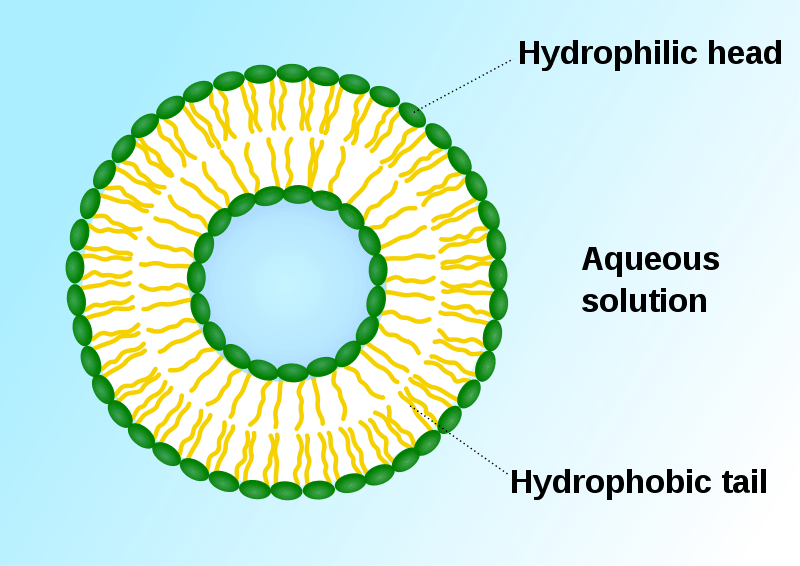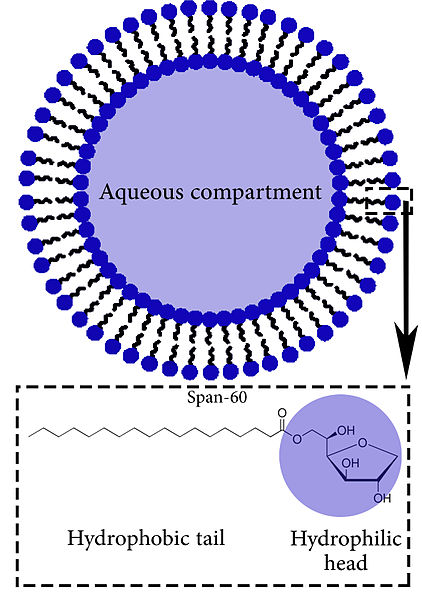The key difference between liposomes and niosomes is that liposomes are delivery vesicles made up of concentric bilayer of lipids, while niosomes are delivery vesicles made up of surfactants with or without incorporation of cholesterol.
Drug delivery is defined as the transporting of a particular pharmaceutical compound to its target site to achieve a desired therapeutic effect. It involves approaches, formulations, manufacturing techniques, storage systems and other technologies important for the delivery of pharmaceutical compounds. The current efforts in drug delivery are more complex and involve areas like current drug delivery are controlled release formulations, targeted delivery, nanomedicine, drug carriers, 3D printing, delivery of biological drugs. Liposomes and niosomes are two types of delivery vesicles that are currently used to deliver drugs and other compounds to target sites.
CONTENTS
1. Overview and Key Difference
2. What are Liposomes
3. What are Niosomes
4. Similarities – Liposomes vs Niosomes
5. Liposomes vs Niosomes in Tabular Form
6. Summary
What are Liposomes?
Liposomes are delivery vesicles made up of concentric bilayers of lipids. Liposomes are drug delivery vehicles used for the administration of nutrient and pharmaceutical drugs. One of the well-known examples of liposomes is the lipid nanoparticles in mRNA vaccines and DNA vaccines. Liposomes were first discovered by British haematologist Alec. D. Bangham in 1961 at the Babraham Institute, Cambridge.

Figure 01: Liposomes
Liposomes can be prepared by disrupting biological membranes through sonication. Often liposomes contain phospholipids, especially phosphatidylcholine. They may also contain lipids like egg phosphatidylethanolamine. Moreover, liposomes may employ surface ligands for attaching to unhealthy tissues. There are four major classes of liposomes: multilamellar vesicle (MLV), smaller unilamellar liposome vesicle (SUV), large unilamellar vesicle (LUV), and chochleate vesicle. A liposome design has an aqueous solution core surrounded by a hydrophobic lipid bilayer. Hydrophilic solutes can be dissolved in the aqueous core, and these solutes cannot pass through the bilayer. On the other hand, hydrophobic chemicals directly associate with bilayers. Hence, liposomes can deliver both hydrophilic and hydrophobic molecules. Furthermore, other than targeted drug delivery, liposomes are currently used for oral delivery of certain dietary and nutritional supplements.
What are Niosomes?
Niosomes are delivery vesicles made up of surfactants with or without the incorporation of cholesterol that can be used for the delivery of drugs and other compounds. Cholesterol is an excipient in niosomes. But other excipients also can be used other than cholesterol. Normally, niosomes have more penetrating capabilities. Though they are structurally similar to liposomes, the materials used to prepare niosomes make them more stable. They can entrap both hydrophilic and lipophilic drugs and deliver them to target sites.

Figure 02: Niosomes
Structurally, niosomes contain non-ionic surfactants of alkyl or dialkyl polyglycerol ether and cholesterol, which are hydrated subsequently in aqueous media. Niosomes have high compatibility with biological systems and low toxicity. Moreover, they are biodegradable and non-immunogenic. Further, niosomes entrap lipophilic drugs into their vesicular bilayer membranes and hydrophilic drugs into the aqueous compartment.
What are the Similarities Between Liposomes and Niosomes?
- Liposomes and niosomes are two membranous vesicles.
- Both can deliver pharmaceuticals drugs and nutrients to the target site.
- These are made up of a hydrophobic bilayer and a hydrophilic core.
- Both are composed of biocompatible and biodegradable materials.
- They are non-immunogenic and reduce the toxicity of drugs.
What is the Difference Between Liposomes and Niosomes?
Liposomes are delivery vesicles made up of concentric bilayer of lipids, while niosomes are delivery vesicles made up of surfactants with or without the incorporation of cholesterol. So, this is the key difference between liposomes and niosomes. Furthermore, the size of liposomes ranges from 10-3000 nm, while the size of niosomes ranges from 10-100nm. Thus, this is another difference between liposomes and niosomes.
The following infographic tabulates more differences between liposomes and niosomes.
Summary – Liposomes vs Niosomes
Liposomes and niosomes are used in various studies for drug delivery and gene transfer. The key difference between liposomes and noisomes is that liposomes are delivery vesicles made up of concentric bilayer of lipids, whereas niosomes are delivery vesicles made up of surfactants with or without incorporation of cholesterol.
Reference:
1. “Liposomes and Niosomes as Potential Carriers for Dermal Delivery of Minoxidil.” Taylor & Francis.
2. Bartelds, Rianne, et al. “Niosomes, an Alternative for Liposomal Delivery.” PloS One, Public Library of Science.
Image Courtesy:
1. “Liposome scheme-en” By SuperManu – Own work (CC BY-SA 3.0) via Commons Wikimedia
2. “Schematic 2” By Saeidmoghasemi – Own work (CC BY-SA 3.0) via Commons Wikimedia
ncG1vNJzZmivp6x7pbXFn5yrnZ6YsqOx07CcnqZemLyue9ahmK1lmah6tbTEZpuinpaav6a6wp5km52krLKmuoyloKmno6S6pr%2BMmqWdZZ6evLS7zJ6qaA%3D%3D